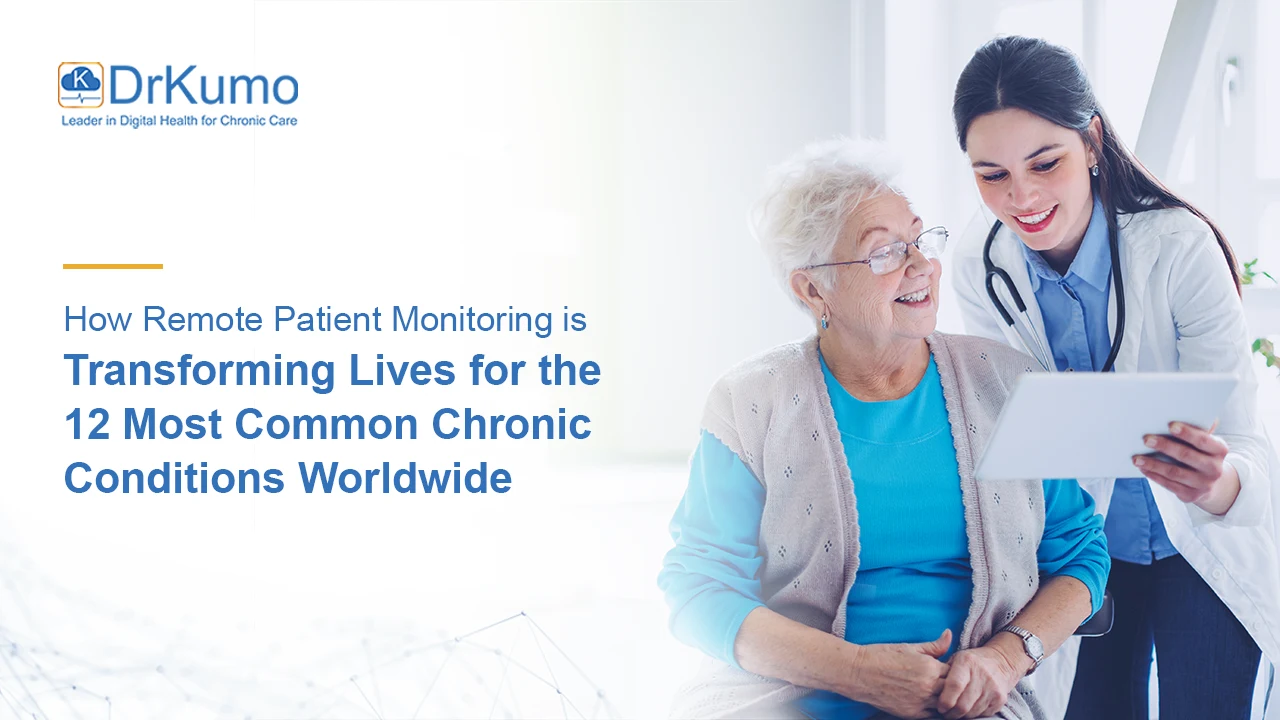In a scenario where managing chronic diseases is as straightforward as using a mobile app, patients can effectively monitor their health from home, receiving continuous support and oversight without the necessity for frequent hospital visits.
Remote Patient Monitoring (RPM) makes this possible by leveraging advanced technology to collect vital health data in real-time. This innovative approach not only allows healthcare providers to track patients’ conditions but also empowers individuals to take charge of their health journey.
Approximately 129 million individuals in the U.S. are affected by at least one major chronic disease, such as heart disease, cancer, diabetes, obesity, or hypertension, according to the U.S. Department of Health and Human Services. With that, the need for effective management strategies is more urgent than ever. RPM has proven to enhance patient engagement and adherence to treatment plans, leading to better health outcomes and reduced hospital readmissions.
Consider the ability to detect potential health issues before they escalate, enabling timely interventions that can greatly enhance patient outcomes. Support the advancement of a more sophisticated healthcare system that prioritizes proactive care and the well-being of patients. Explore how RPM can transform chronic disease management in your practice or personal health journey today.
The Impact of Chronic Diseases on Health and Well-Being
Chronic diseases, such as diabetes, heart disease, and chronic obstructive pulmonary disease (COPD), are increasingly prevalent and significantly impact individuals’ health and quality of life.
Given the substantial burden these diseases pose, Remote Patient Monitoring (RPM) has emerged as a vital tool in addressing these challenges. It enables healthcare providers to offer continuous support and tailored interventions that enhance patient outcomes.
By integrating RPM into chronic disease management programs, healthcare professionals can monitor patients’ vital signs in real-time, allowing for timely interventions and personalized care plans. This proactive approach not only improves health outcomes but also empowers patients to take control of their conditions, leading to better adherence to treatment regimens and lifestyle changes.
As we delve deeper into the benefits of RPM for chronic disease management, it becomes clear that leveraging technology is essential for improving health outcomes and enhancing the quality of life for those affected by chronic illnesses.
The Rise of Remote Patient Monitoring
RPM has become a critical tool for managing chronic diseases, enhancing patient care through innovative technology and data-driven insights. Here are some key insights into the rise and impact of RPM:
- Acceleration Due to COVID-19: The pandemic highlighted the need for efficient healthcare delivery without compromising patient safety, leading to a significant shift towards Remote Patient Monitoring (RPM). According to a report by McKinsey, telehealth adoption in the United States surged from 11% of Americans utilizing telehealth services in 2019 to 46% in 2020 during the COVID-19 pandemic.
- Provider Confidence: According to a report by Deloitte, 42% of healthcare providers believe RPM significantly enhances patient engagement and adherence to treatment plans.
- Real-Time Data Collection: RPM enables healthcare providers to monitor patients’ vital signs and health metrics from virtually anywhere, facilitating timely interventions.
- Addressing Medication Adherence: Patients in the U.S. do not take their medications as prescribed, contributing to an estimated 125,000 deaths annually. RPM technologies provide reminders and alerts to improve adherence.
- Frequent Monitoring for Chronic Conditions: RPM allows for daily or weekly data gathering, enabling healthcare providers to assess treatment effectiveness and make real-time adjustments.
- Reduction in Hospital Readmissions: Studies indicate that RPM can lead to a 50% reduction in hospital readmissions for patients with chronic heart disease by facilitating proactive interventions.
- Integration with Telehealth Services: The combination of RPM and telehealth allows for comprehensive care management, where patients receive virtual consultations alongside their monitoring data.
- Cost Implications: With 90% of healthcare costs in the U.S. attributed to individuals with chronic diseases, effective management strategies provided by RPM are urgently needed.
- Transformative Approach: RPM is not just a temporary solution; it empowers patients and enhances the quality of care provided by healthcare professionals, making it an indispensable tool in chronic disease management.
How RPM Works
Remote patient monitoring systems utilize various devices and applications to collect health data, including:
- Wearable Devices: Smartwatches and fitness trackers that monitor heart rate, activity levels, and sleep patterns.
- Mobile Health Apps: Applications that allow patients to log their symptoms and health metrics, which are then transmitted to healthcare providers.
- Connected Medical Devices: Instruments like blood glucose monitors and blood pressure cuffs that send readings directly to healthcare systems.
Once the data is collected, it is securely transmitted to healthcare providers for evaluation. If any metrics fall outside predetermined thresholds, alerts are generated, allowing for timely interventions before complications arise.
The Top 12 Most Common Chronic Diseases Benefiting from RPM
- Diabetes: RPM tools such as connected glucose monitors enable continuous tracking of blood sugar levels, leading to better management and lower hemoglobin A1c levels. Studies show that patients engaged in remote monitoring achieve improved diabetes control, reducing complications.
- Hypertension: Real-time monitoring of blood pressure through RPM systems helps prevent emergencies and allows for timely medication adjustments, significantly lowering the risk of heart attacks and strokes.
- Chronic Obstructive Pulmonary Disease (COPD): RPM enables patients to track lung function and breathing patterns, allowing healthcare providers to optimize treatment plans and reduce hospital admissions.
- Heart Disease: Continuous monitoring of heart rate and rhythm can lead to early detection of potential issues, enabling proactive interventions that can prevent serious complications.
- Asthma: RPM systems help patients monitor their respiratory health, providing alerts when symptoms worsen, which can prevent severe asthma attacks.
- Chronic Kidney Disease: By tracking vital signs and lab results remotely, healthcare providers can manage treatment more effectively and reduce the need for dialysis or hospitalization.
- Obesity: RPM encourages lifestyle changes through regular monitoring of weight and physical activity, fostering a proactive approach to weight management.
- Alzheimer’s Disease: Remote monitoring can assist caregivers in tracking behavioral changes and ensuring medication adherence, improving the quality of life for patients.
- Multiple Sclerosis (MS): RPM allows for continuous assessment of symptoms, enabling timely adjustments in treatment plans that can enhance patient well-being.
- Parkinson’s Disease: Patients can use RPM tools to monitor motor symptoms and medication effects, leading to more personalized care strategies.
- Chronic Pain Conditions: RPM can help track pain levels and medication usage, allowing healthcare providers to adjust treatment plans based on real-time data.
- Depression and Anxiety: Remote mental health monitoring tools can facilitate regular check-ins with healthcare providers, improving treatment adherence and outcomes for mental health conditions.
Key Benefits of RPM in Chronic Disease Management
- Early Detection of Health Issues: RPM allows for continuous monitoring of vital signs such as blood glucose levels and heart rates. For instance, diabetic patients can receive alerts if their blood sugar levels fluctuate outside the normal range, prompting immediate action to prevent complications. A recent study found that RPM can reduce hospital readmissions for diabetes patients by up to 50%, demonstrating its effectiveness in early detection and intervention.
- Personalized Treatment Adjustments: By analyzing real-time data collected through RPM devices, healthcare providers can adjust treatment plans based on individual responses. This is particularly beneficial for patients with heart disease who may require medication adjustments based on daily monitoring of their heart rate and blood pressure.
- Enhanced Patient Engagement: RPM encourages patients to take an active role in managing their health. With easy access to their health data via mobile apps or connected devices, patients are more likely to adhere to treatment regimens and make healthier lifestyle choices.
- Cost-Effectiveness: Implementing RPM systems can lead to significant cost savings by reducing the need for in-person visits and minimizing hospital admissions. Studies show that RPM is particularly effective for managing cardiac conditions like hypertension and heart failure.
- Improved Quality of Life: By enabling continuous care and support, RPM enhances the overall quality of life for patients with chronic diseases. For example, COPD patients can use remote monitoring to track their respiratory health, leading to better management of their condition and fewer exacerbations. Research indicates that RPM can decrease COPD exacerbations, significantly improving patients’ daily functioning and well-being. This proactive approach not only helps patients feel more secure but also reduces the burden on healthcare systems.
The Future of Remote Patient Monitoring
As healthcare technology continues to evolve, the future of remote patient monitoring (RPM) holds immense potential for transforming patient care. Here are some key developments and trends shaping this promising landscape:
Advancements in Technology:
- The future of RPM is promising, driven by continuous technological innovations.
Integration of AI and ML:
- Enhances data analysis capabilities.
- Enables personalized care strategies tailored to individual patient needs.
- Predicts potential health risks through real-time data analysis.
- Allows for early interventions, improving patient outcomes and reducing hospitalizations.
Expansion of 5G Networks:
- Improves connectivity and reduces latency in data transmission.
- Facilitates continuous monitoring and instant alerts for healthcare providers.
- Enhances the effectiveness of RPM solutions, especially for chronic disease management.
Increased Efficiency for Healthcare Providers:
- Automates data analysis, providing actionable insights.
- Frees up valuable time for clinicians to focus on direct patient care.
- Reduces burnout among healthcare professionals.
Enhanced Patient Engagement:
- Integration of telehealth platforms with AI-driven RPM solutions.
- Virtual health assistants guide patients through daily health checks and offer personalized education.
- Empowers patients to take an active role in their care.
Holistic Approach to Patient Care:
- Provides healthcare providers with a complete picture of patients’ health.
- Ensures comprehensive support for managing chronic conditions effectively.
DrKumo’s RPM Solutions: Empowering Chronic Disease Management Through Innovative Technology
DrKumo’s Remote Patient Monitoring (RPM) solutions are at the forefront of revolutionizing chronic disease management. By harnessing cutting-edge technology, DrKumo enables healthcare providers to monitor patients’ health in real-time, facilitating timely interventions and personalized care.
This innovative approach not only enhances patient engagement but also significantly improves health outcomes for those living with chronic conditions such as diabetes, heart disease, and COPD. With DrKumo’s user-friendly platform, healthcare professionals can easily collect and analyze vital health data, ensuring that patients receive the proactive care they need to manage their conditions effectively.
Takeaways
As chronic diseases continue to rise in prevalence, Remote Patient Monitoring stands out as a critical tool in enhancing patient care and outcomes. By leveraging technology to facilitate real-time health monitoring, healthcare providers can offer personalized interventions that empower patients to manage their conditions effectively.
Discover how DrKumo’s advanced Remote Patient Monitoring (RPM) solutions can streamline your workflows, reduce administrative burdens, and enable timely interventions for your patients. With real-time data access and automated health monitoring, you can focus on delivering high-quality care while increasing patient satisfaction and engagement. Contact us to explore more practical benefits of RPM for healthcare providers today.
Disclaimer: The information in this article is for educational purposes only and should not be considered medical advice. Always consult a healthcare professional for personalized guidance regarding Remote Patient Monitoring and chronic disease management.








